Admin
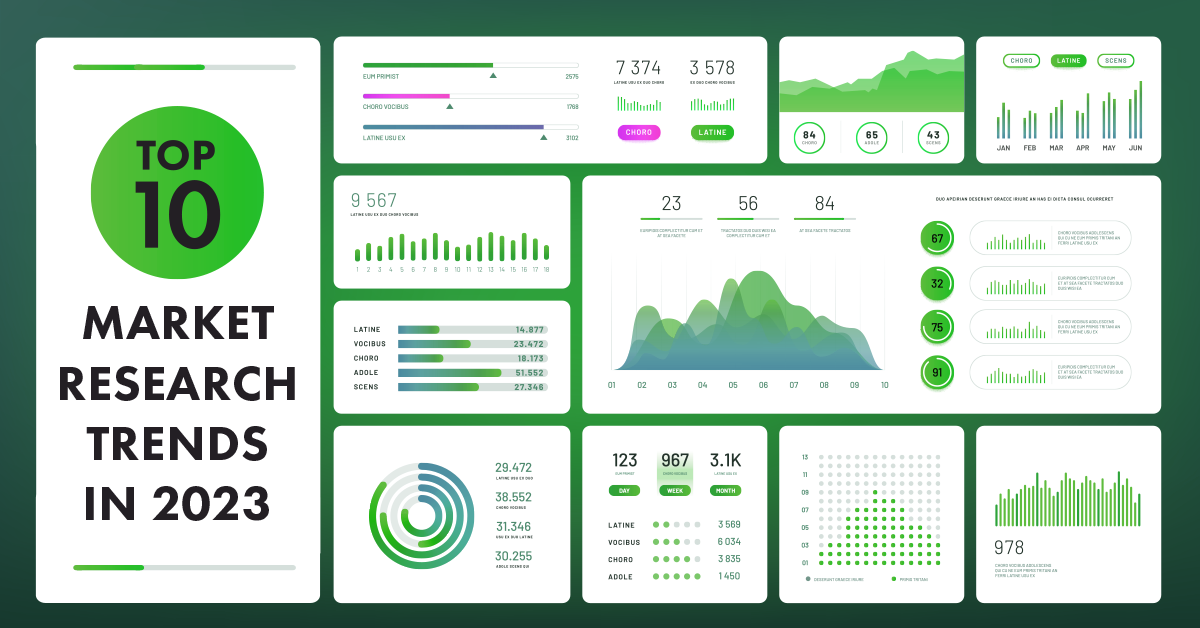
Blog Summary
The blog discusses the rapid evolution of market research influenced by technologies like AI, and the pressing need for brands to adapt to maintain consumer loyalty and capitalize on emerging market opportunities.
Key Points Overview
Top Takeaways
Conclusion
In today’s fast-evolving market landscape, staying ahead requires brands to adopt advanced market research tools and strategies. These allow brands to quickly respond to changes, understand consumer needs, and navigate potential risks, ensuring continued growth and consumer loyalty.
What worked yesterday in your market research strategy won’t work today. The world is evolving and speeding ahead at a frightening pace—and brands that don’t adapt fast enough could experience a decrease in consumer loyalty and love.
However, market research offers white space opportunities that provide insights into emerging trends. It also opens the door to new perceptions of the market and consumers’ fickle moods, which are changing with the wind. Tracking these market research trends over time helps brands connect with consumers in a way that resonates—nurturing long-lasting relationships.
The only constant in business is that tomorrow, the market will change. But with consumer and market intelligence, savvy brands can remain agile and able to pivot at a moment’s notice—keeping shipping lanes open to you.
Baseline metrics help you plot your course to your destination, while the ebb and flow of global trends can help you best determine when and where to put out to sea. Here, we’ll look at the top ten market research trends in 2023 that will get you from point A to point B with the least amount of frustration. And they’ll help you maneuver around and avoid any storms.
To begin, let’s look at a few market research statistics of interest:
First, we’ll share how market research tools have changed, and then we’ll dig into the research trends!
In the 1920s, the first inklings of proper market research began, and qualitative questionnaires were king. It all started with a man named Daniel Starch, a trained psychologist and mathematician, who started approaching people on the streets and asking if they remembered any particular ads from popular publications they had read. Then, he’d take this information and cross-reference it with circulation counts to determine which advertisements were the most effective.
In hindsight, it seems extraordinarily rudimentary, but it was a step in the right direction. The only tools you needed were a pair of shoes and a notepad. And while the results were by no means exhaustive, they were a vast improvement over the methods employed in the past – which were next to none. Journalists simply wrote advertisements and hoped people read them.
Quantitative surveys and focus groups remained the primary market research methods for collecting consumer intelligence into the 1960s. Then, as computers became accessible for research, focus on statistics and hard data became the aim. It had become apparent in the industry that there was a disconnect between what consumers said they did – and what they really did. Market research that captured insight into these discrepancies became attainable through processing power.
The ubiquity of the internet opened new doors to data acquisition for researchers expanding accessibility to consumers’ thoughts, feelings, and behaviors. We are now firmly rooted in the digital era, where advances in cloud computing and artificial intelligence elevate 24/7 access to consumer data with the means to store and evaluate vast data sets.
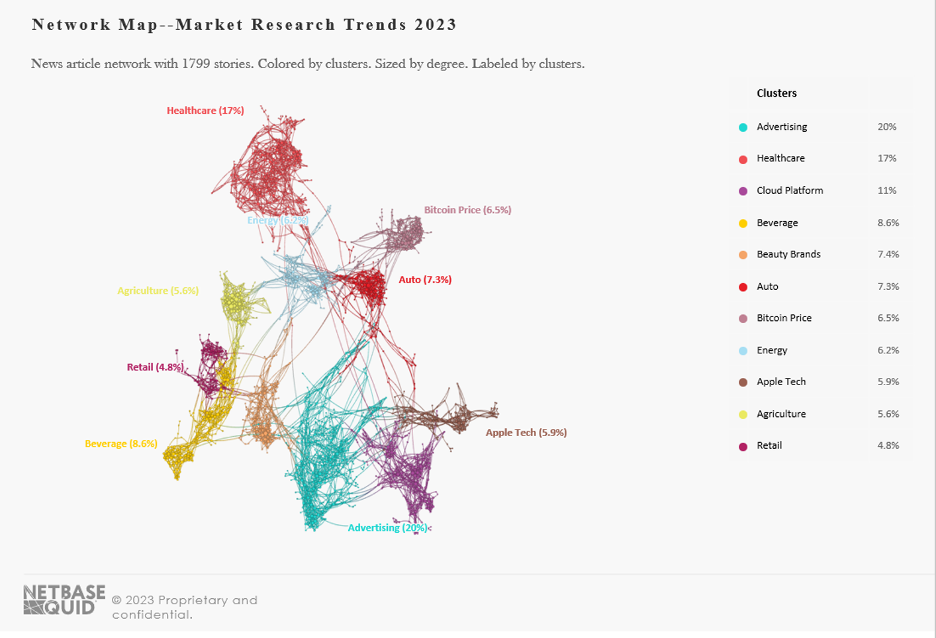
Data visualization of top ten thematic clusters in market research from top-tier US news sources. 1/1/21-1/1/23
Disruption has been the name of the game for the past few years, so it pays for brands to be on top of the latest research. So let’s dig into those research trends to see what’s on tap this year!
Your brand needs an all-encompassing view that aggregates consumer and market intelligence to be in the best position to strategize and minimize risk. That means pulling data from every conceivable resource.
The more data sets you can get your hands on, the better informed you’ll be, plain and simple. But like everything in life, balance is crucial. If you lean too heavily into the social conversations surrounding your brand without understanding the market forces at work, then your knowledge of your brand positioning will be lopsided.
Conversely, a rock-solid understanding of market conditions without firm footing along social media trend lines could cause you to undershoot your messaging with vast swaths of your target audience.
If your competitors are consistently outmaneuvering you in a particular area, odds are they’re more informed than you. Agility in business isn’t built on bravado but on a holistic consumer and market intelligence approach. After the past few chaotic years brought on by the pandemic, and now with the risk of a recession in North America and Euro zones looming, brands across industries are in an arms race for intelligence. It’s a race to the top, and the winner is the one that can pivot first. Without good intel, brands make costly mistakes that negatively affect the bottom line.
2021 was a definitive year for brands coming out of the pandemic; consumers emerged changed as well. They became more vocal, calling out companies for any misstep—a trend that would flow into 2022. And the entire past year had its fair share of turbulence for brands trying to understand the voice of the consumer—a voice that has grown louder and more demanding.
Additionally, “two-thirds of consumers were feeling somewhat or a lot worse regarding prices for food/consumer goods, fuel/gasoline prices, cost of housing, the overall cost of living, and international relations/wars,” according to DriveResearch. With an expected recession on the horizon and consumer demands that brands get everything right, the importance of turning on a dime is top of mind. Brands have become tenacious about guarding against unforeseen risk, and with that has come a deep thirst for accessible and actionable intel built on a robust data network.
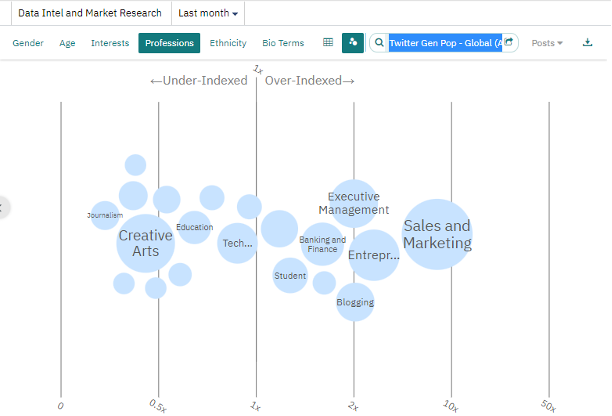
When examining who is generating the most conversation about data intelligence, we see Sales and Marketing, Entrepreneurs, Executive Management, and Banking and Finance over-indexing – as these groups recognize the growing importance of making data-informed decisions.
For the sake of speed, siloed data is a pent-up resource and a barrier to agile decision-making. So now more than ever, your understanding of brand position should cut across every data silo, including internal data, consumer and social intel, and strategic market intelligence.
Your consumer intelligence should be built on social media analytics, employee and product reviews, surveys, etc., in addition to your logistical purchase data to inform a deep and robust viewpoint into your voice of the customer (VoC). Likewise, your competitive intelligence should include the same insights and be as vigorously informed.
For example, look at the intel from Glassdoor reviews alone. And this is precisely the kind of data that can be uploaded into your market research tool to form a complete understanding of your organization.
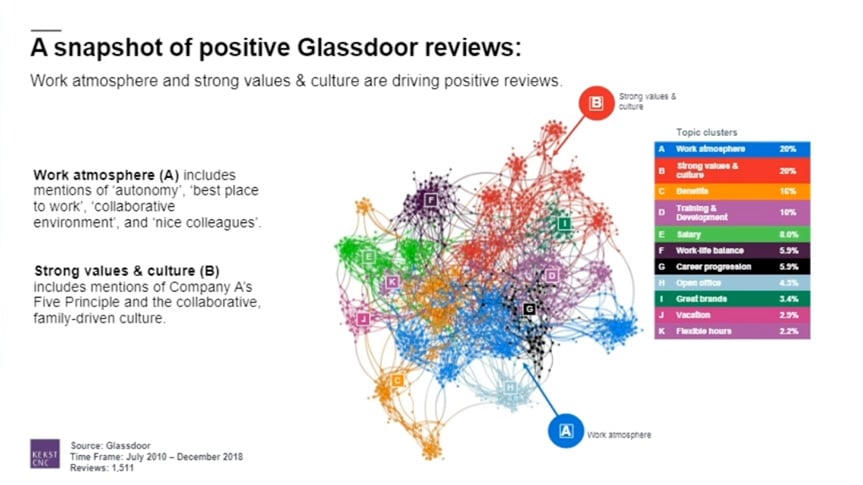
Your market intelligence should be a top-down approach with a cohesive understanding of global positioning, trends, and competitive movement. Dialing down into your category, you may need access to data on the M&A and patent landscape surrounding you. Any unstructured data you can get your hands on, such as earnings call transcripts, that informs about the competition is paramount to gaining the edge.
This year, the difference between first movers and laggards will be bountiful access to meaningful data across the consumer and market spectrum. To come out on top, your market research tools need to handle whatever you throw at them – and that should be a lot.
Traditional research methods are going the way of the horse and buggy. Markets move too fast in our global economy for them to maintain relevancy. For instance, uploading available consumer product reviews into your data analytics tools takes moments and allows you to parse the data down to a granular level.
Achieving insight at speed is a game-changer by integrating artificial intelligence into your market research. The speed and functionality of machine learning is growing daily, leading to a rush to adopt the technology as the fastest means to overall market intelligence.
Standard methods, such as surveys, focus groups, etc., are too slow and cumbersome to compete. By the time company A has acquired and processed its survey results, company B has already informed its decision-makers, formed a strategy, and made a move. In the future, those brands and institutions that still need to implement artificial intelligence at scale will be forced to play a perpetual game of catchup. As such, this is one of the hottest research trends on the planet right now.
Artificial intelligence enables you to parse massive data sets, cut away the noise and find deep insights that traditional methods could only dream about. And it doesn’t need to take a lunch break.
AI-powered data analytics breaks down the VoC into components to reveal trends and insight across a spectrum of indicators within the human language. The cost of human researchers using traditional methods to achieve such rich insights at scale would be so prohibitive that it’d be ludicrous to attempt. And it wouldn’t approach real-time processing rates that are standard for next-generation AI.
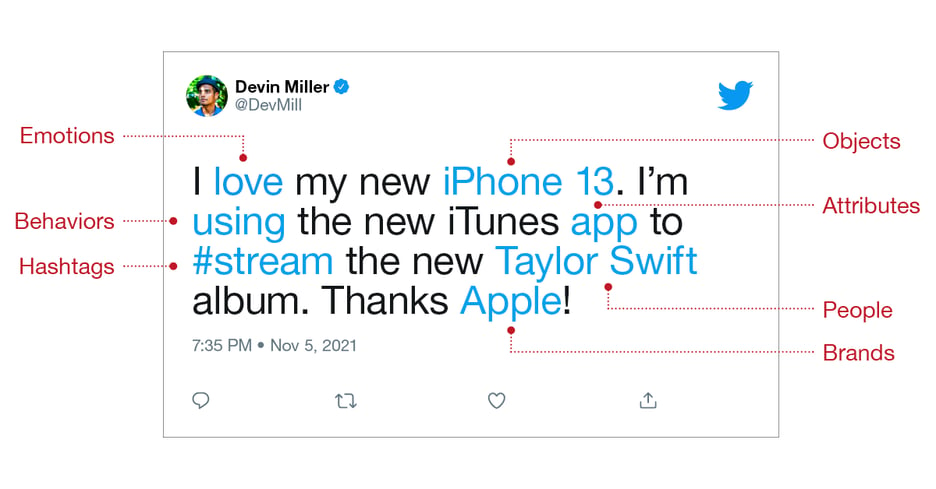
Agility is the future of business, and speed to insight is one of the most important aspects of being a front-runner in today’s marketplace. AI is gorging on market share at an estimated 46% CAGR through 2025, with market growth reaching USD by this year. And the market research industry has a big appetite for the tech. Those companies and industries that need to adapt will find themselves starved for information.
You have enough trouble keeping up with your market, and now you need to understand adjacencies better too? Yes. We’ve mentioned the importance of turning on a dime, and you’re one pivot away from intruding on each other.
When it comes to a crisis, it’s not a matter of if … it’s a matter of when. For example, suppose you are underinformed on adjacent markets when a crisis hits. In that case, you very well may have an unwelcome guest eating from your table – especially if they were already informed about you.
What do you do then, should a natural disaster or supply disruption throw off your standard business approach? When external events, like a recession, impact consumers’ buying behaviors, brands need to have other ideas up their sleeves to pull through. If the market for your business dried up today, what strengths do you have that could get your foot in the door of an adjacent segment?
It’s hard not to mention the pandemic as an example of why brands need agility to pivot as needed. And with the following year posing financial challenges to consumers via a recession, we hope companies have learned their lesson so they can make the necessary changes before it hits their bottom line too hard. So let’s dive into an example of one company that has weathered the changes brought on by the unforeseeable
Uber Eats was the vehicle that brought Uber through the most challenging part of the pandemic. Then, they pivoted to focus on what consumers needed most—comfort in the form of their favorite foods delivered safely to their door. And Uber hasn’t stopped innovating since.
Most recently, Uber Technologies announced a long-term partnership with autonomous vehicle developer Nuro: this zero-occupant, self-driving EVs will deliver food to Uber Eats customers around the US.
Uber Eats has weathered the worst and shown that they have staying power, cementing its spot at the top of the meal delivery segment. And we can tell by the most recent consumer intelligence that their audience base approves, with sentiment sitting at 53%.
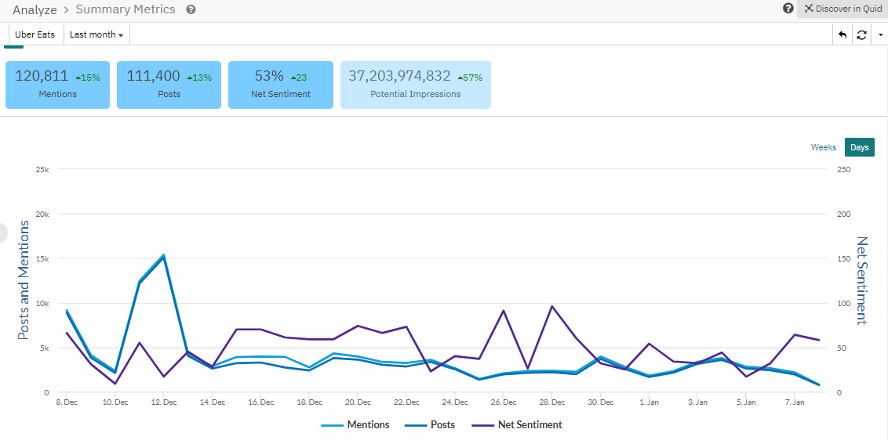
Uber Eats social media conversation and net sentiment. 8/3/21-1/3/22
Pivoting to another focus area and quickly transitioning catapulted Uber to the top of the food delivery game.
Do you have a plan B for when things go south or a plan to diversify when needed? You do now, and it’s to move sideways.
You should know your adjacent markets backward and forwards, and there’s a secondary reason for doing so. What if it’s not you that has a crisis but your adjacent sector? They could potentially turn their eyes to your piece of the pie. Of course, you can’t plan for every scenario under the sun, but if you are already aware of who they are and what they do, you are better prepared to fend them off your territory than if you were starting from scratch.
Nevertheless, take a page from Uber’s playbook. That’s how it’s done.
Consumers are researching brands like never before, a trend showing no signs of slowing down. At the onset of the pandemic, we found that people were beginning to look for brands aligned with their values. Three years later, that has become standard consumer behavior – particularly with Gen Z.
Whether it’s the environment, sustainability, black-owned businesses, saving the whales, or ethical fashion, consumers are doing their homework on you. Brands that need to pay more attention here stand to lose customers to their competitors who’ve taken it to heart.
Silence isn’t a viable option here, and neither is having an archaic mission statement. Forward-thinking brands paying attention to consumer trends have already made adjustments and backed them up with action. If a customer goes on your website and your mission statement reads like a webpage from 1998, those dollars will not end up in your war chest.
Savvy consumers are looking at brands now as an extension of their personalities. They’ve done the hard work of researching where their money goes, and it’s essential to them. To them, if your mission statement has aged like milk, it’s incredibly off-putting. They want products and services from a brand that pays attention to the social and environmental concerns they’re concerned with – and acts on them in a meaningful way.
That means you need a new mission statement backed up by action. If you really want to go over the top, have your work independently verified by a third-party organization to build trust. Consumers are naturally skeptical of brands, so anything you can do to lessen that tension is a win.
Patagonia is an excellent example of a mission statement done right. They’ve stayed true to who they are as a company and built a legion of loyal customers along the way. Additionally, they walk the walk.
Recently, Patagonia co-founder transferred his ownership to a trust that will combat climate change and protect undeveloped land around the globe. Patagonia recognized what was important to their target demographics, and put rubber to the road.
“One of the things that we’re really focused on … is aiding and educating civil society to be more able to make a positive environmental impact.” Alex Weller, Director of Marketing at Patagonia Europe (from Brand The Change interview)
They’re outright aggressive with their environmental activism and great about telling the stories surrounding the brand’s actions. A look shows social media users talking about ecological issues relative to the brand. Isolating environmental keywords from the narrative on a bar chart colored by sentiment shows us whether these conversations are healthy. Sentiment plays an active role in how consumers perceive your brand and whether or not they’ll choose to purchase from you, so brands should always count sentiment.
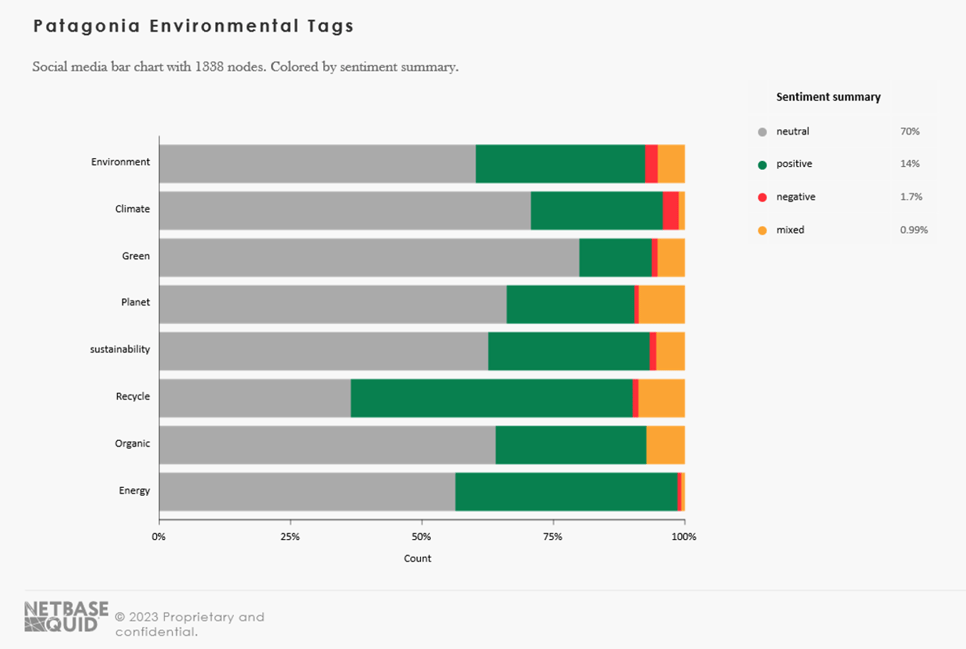
Eight environmental keywords used by social users discussing Patagonia. Colored by sentiment. 10/3/22-1/3/23
In any case, revisiting your mission statement isn’t a pie-in-the-sky endeavor. It still represents who you are as a brand. But showing that you’re paying attention goes a long way. Putting actions behind your words is the icing on the cake in the consumer’s mind.
Use your market research to inform your efforts here, as it’s foolish – and potentially harmful – to guess. For example, armed with an understanding of global trends, Patagonia’s mission statement could practically write itself based on the top keywords alone.
Your brand’s social media conversations will indicate what trends closely resonate with your target audience. Highlight them in your mission statement. Show the customer that you have noticed and aligned with their values, and you will strengthen your brand story and the customer experience.
Smart surveys are another trend within the broader torrent of the global digital transformation rush that is gaining heavy adoption within the market research industry. And it makes sense as traditional methods of collecting survey data are comparatively slow and cumbersome. Not only that, but a well-implemented digital survey also captures a better response rate and does it faster than traditional methods.
Since speed to insight is the name of the game in modern market research, adding this data collection tool to your arsenal is critical to capturing targeted intel. Surveys are how market research started, and they still have a place in today’s methodology to extract insights from crucial moments in the customer journey. The goal is the same, but the tactics are better.
A traditional survey sent through the mail is a gamble. Getting a response depends on whether the consumer receives the survey, is in the mood to fill it out, and if the response choices align with their opinions. If any of these pieces are missing, then you’ll receive nothing, and it’s throwing money in the trash. Additionally, one consideration is accessibility.
A mobile-first approach is showing promise as more consumers use their cell phones for everyday tasks—in fact, mobile accounts for approximately 50% of web traffic worldwide. Yet, only 64% of market researchers presently use mobile surveys.
If the past few years have taught us anything, it’s that you have to meet the consumer where they are. Unfortunately, consumers are increasingly looking for scammers and nefarious motives on the digital spectrum. If surveys are poorly timed or incentivized in a way that makes the consumer feel like it’s a bait and switch, then they’ll feel taken advantage of.
It’s an unfortunate reality for consumers that brands should keep top of mind when developing their smart surveys. When you get it right, your audience will jump at the chance to provide feedback.
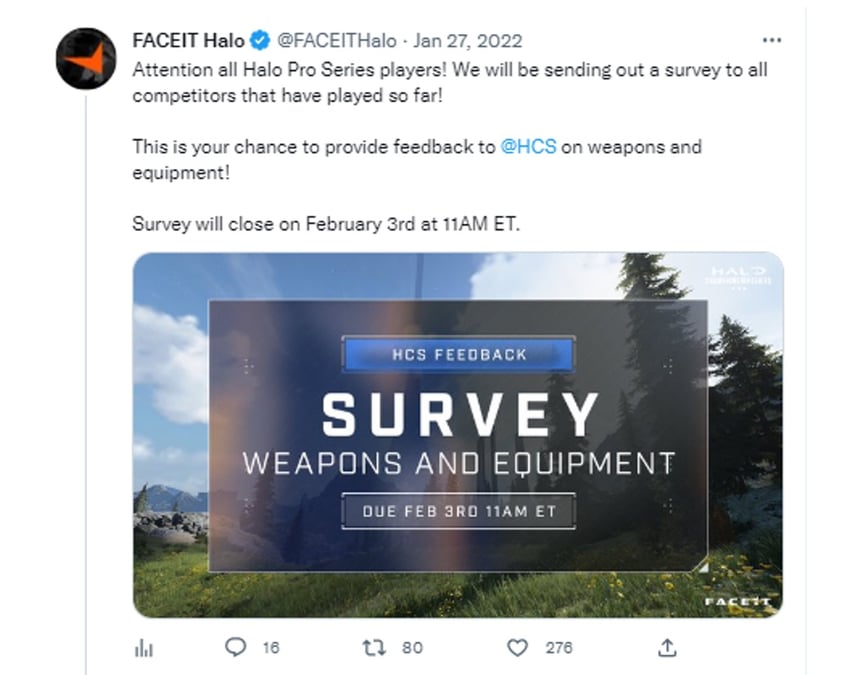
Once you design and implement smart surveys that capture honest feedback at an opportune moment in the customer journey, the rewards will be well worth the effort. And your customers won’t feel imposed upon. On the contrary, if your survey properly incentivizes the consumer, they will be happy to provide feedback since you’ve given them a sense of additional value for their time.
The brand-specific consumer intelligence that smart surveys can unlock adds to your holistic consumer and market intelligence. The widening adoption of AI, chatbots and personalization at scale allows you to craft personalized surveys in-app or pre/post-checkout to humanize the interaction further when the customer is most heavily invested in your brand.
Examples of forward-thinking smart surveys can include emotion-based surveys using facial recognition cues in focus groups, or unintrusive feedback gleaned through curated communities attached to your CX strategy. Sentiment around smart surveys is riding a wave of positivity right now, so outmaneuvering your competition here is the intelligent thing to do. Whatever way you choose to approach smart surveys, market research will inform you of your target audience’s best approaches, minimizing wasted time and maximizing response rates.
In the future, a trend that will be the differentiator between brands that outlast their competitors is social media listening in real time. With the always-on manner of social media echoing social, economic, and political trends, doing business is akin to running through a minefield. Of course, some social listening is better than none, but if you’re going to make the long run, real-time monitoring is where it’s at.
Your brand’s longevity depends on avoiding social missteps and capitalizing on consumer intelligence. A study by Innosight found that in 1964 the average age of companies on the S&P 500 was 33 years old. By 2016 the average age had dropped to 24, and by 2027 is forecast to dwindle to just 12 years.
Couple that with the fact that 88% of companies that comprised the Fortune 500 in 1955 no longer exist, and you can see that longevity is not guaranteed. The way to hedge against going the course of the dinosaurs is by keeping tabs on the social climate as it happens with a thorough understanding of emerging trends.
If you were to run an analysis on social listening mentions, you’d find that monitoring and managing misinformation are in the top five conversational themes. These are the issues your competitors are paying attention to. Since social never sleeps, that means the potential for market influence doesn’t either.
So, if you’re on the golf course on Sunday and your brand mentions go through the roof because one of your social media posts hits on the wrong side of a hot-button social issue, you need to know that – fast. And setting up alerts on your social media analytics tools for when activity moves outside your baseline metrics ensures
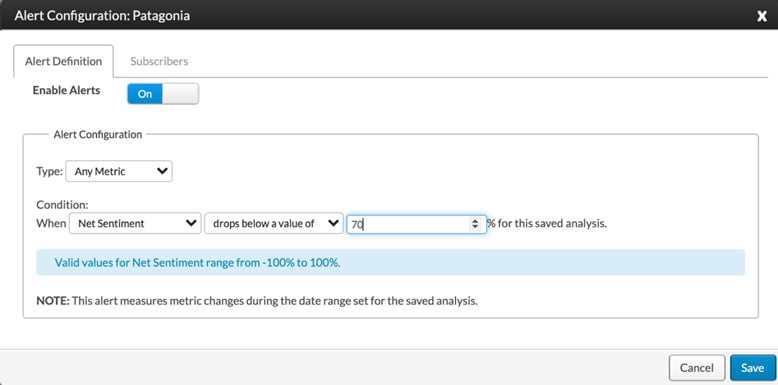
Consider real-time social listening like a stop-loss order against a potential crisis to safeguard your brand’s longevity. The sooner you’re informed, the better.
Speaking of baseline metrics, accuracy is paramount. When aggregating your metrics from disparate analytics tools, you must pay extra careful attention to ensure something isn’t lost between your sources. Even if you use a dedicated social listening platform, you should ensure that your metrics are uncluttered by noise.
What does that mean exactly? If you are doing a social media audit on your brand to reassess your brand’s sentiment, for example, you have to know that your data is untainted by off-topic mentions, similar hashtags, or spam content. A clean dataset gives you clarity on the health of your brand. If it’s muddied by clutter, then you will not have an accurate representation of your brand to start with.
And that means your subsequent brand health analyses will be measured against faulty metrics. And this will also be the case if the data analytics tools you are using are incapable of slicing your data down to a granular level.
Quality is king when establishing your brand’s metrics. Otherwise, your measurements are an exercise in futility and of little use to your efforts. As such, your tools should be transparent enough to dig all through the mentions it pulls in. A robust set of filters and Boolean search capabilities allow you to eliminate all the excess, leaving you with a new data set relevant to your query.
For example, setting up our brand analysis on Patagonia, we knew we’d have to separate the brand from its namesake region in South America for accurate consumer insights. Knowing this, we excluded terms such as Chile, Argentina, and South America. If our analysis of Patagonia’s brand left any of those mentions included, it would skew our brand metrics.
However, you can see in the sentiment drivers below that the ‘condor repopulation drive’ and “face wind farm threat” terms don’t look like they belong. These terms come from articles about people freeing Andean condors in South America. Fortunately, it’s a quick fix to filter out this term along with any others we find along the way. And this is great for any analysis where your terms share similarities with other products, people, brands, and places.
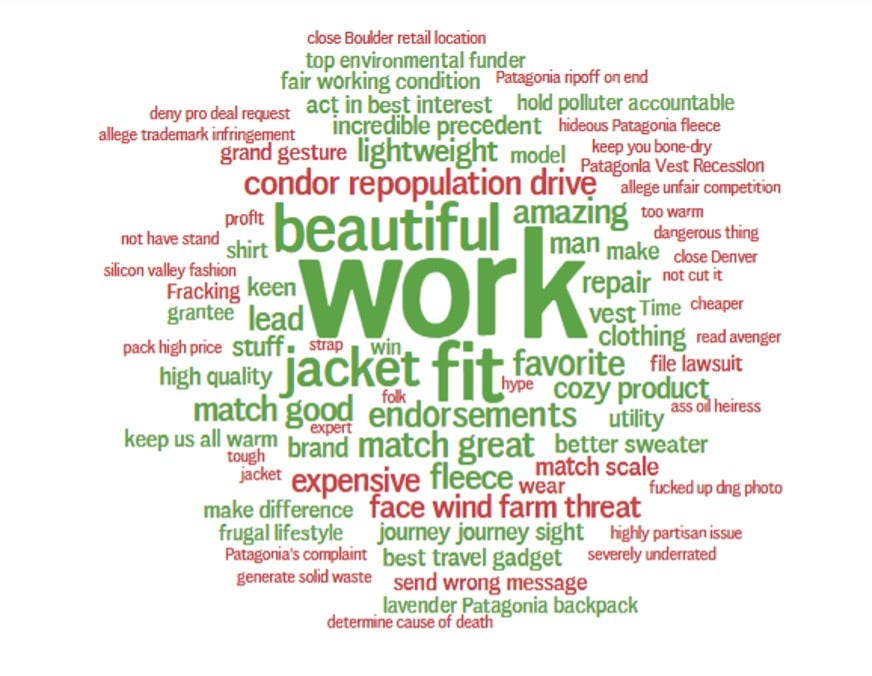
The ability to drill down and cut away all irrelevant posts gives us a clear picture of the brand we can trust. And that’s what’s driving this research trend – a hunger for quality metrics built on unflinching accuracy.
Getting clean results in your social data sets is supremely important, and your tools have to get you there. Social media will talk about any significant event. So, as an example, if the news of condor repopulation were to trend and we’d negligently leave those mentions in our brand analysis–when we went to benchmark over time, we’d then be left wondering why our impressions and “mentions” were vastly different.
That’s a headache you don’t have to have. Clearing away the social media clutter makes your analysis actionable – and you can confidently measure against it in the future.
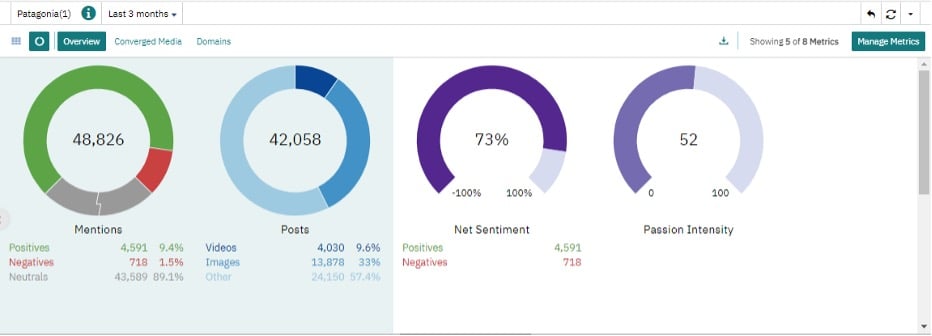
Patagonia brand discussion summary metrics. 10/8/22-1/8/23
That’s why top brands demand pinpoint accuracy from the start, with transparent and fine-tuned results. And you should too.
Understanding how trends fluctuate over time provides the context for market movements. Trend tracking is not a ‘set it and forget it’ scenario for your market intelligence. Instead, ongoing trend analysis is critical in informing your brand when to pull back and when to push through.
Yes, some trends gushed last year, and others retracted due to the change in consumer behaviors born out of the events of the past few years–from the pandemic to social unrest. And while this year presents its own challenges in moving past turmoil and into the future, there is no guarantee that trends will behave logically.
Since markets are temperamentally unpredictable, trends are directly affected by the moods that influence the whole. So just because sustainability has been a growing trend for many years doesn’t mean you can base your initiatives around it and ride off into the sunset.
That kind of thinking is trouble and why many brands no longer exist. In other words, hitching your brand to a current trend may pay dividends in the short run, but it’s a giant gamble to set anything on autopilot long-term. Trends have a way of swelling, retracting, and branching off in new directions, and brands are paying attention to long-term movements to inform their strategy like never before.
Cryptocurrency and blockchain technology has been white-hot over the past few years, and it has grabbed the attention of influential people such as Elon Musk. However, it has been a tumultuous year for cryptocurrency. In 2022, we witnessed Terra Luna being worthless, Celsius going bankrupt, and FTX’s founder getting arrested on alleged fraud charges. That being said, industry professionals are optimistic that the cryptocurrency trend will continue into 2023.
This optimism relies on the past performance of crypto markets, which suggests that this will be a good year for virtual currencies. And regardless, Bitcoin is in for a wild ride this year, according to Forbes—with other industry professionals predicting more crashes even worse than in 2022, and some thinking Bitcoin will disappear forever.
Nevertheless, the decentralization properties of blockchain technology still have disruptive potential for governments and financial institutions – and they are paying attention. Others are getting in on the action, too. But companies will want to track it over time to ensure they don’t get too far in over their head if the bottom drops out of cryptocurrency as some predict. Here’s a look at a company dataset in NetBase Quid® showing a timeline view of investment into companies involved with Bitcoin.
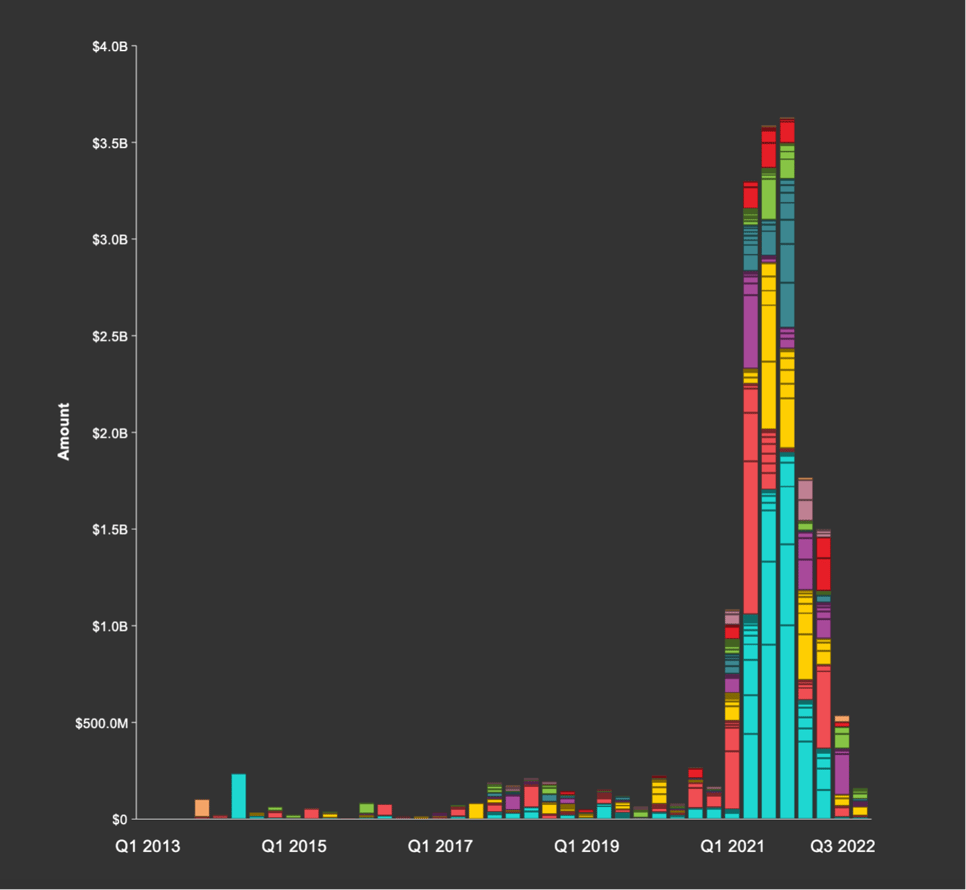
Investment in companies dealing with Bitcoin. 2013-2023
If this industry could touch you, you’d want to know about the considerable spikes, or dips, in investment over the past year. A look at the patent activity in the cryptocurrency space over the last five years is also telling. For example, there have been over 1,200 patents applied for in that time, of which 345 have been granted. In 2021, that number stood at 235—something to think about and watch as the next year unfolds, particularly as it seems 2022 was light in comparison.
Longitudinal trend tracking keeps surprises to a minimum, leaving your brand in the best position to pivot no matter how the tides turn. And following the money and the innovation shows whether a trend has teeth.
Due to the rapid adoption of e-commerce on the back of consumers wanting more convenience and a safer way to shop during the pandemic, many brands have been rethinking their CX strategy. Our “new normal” has become “just normal,” and it’s doubtful we’ll ever return to the way things were. And e-commerce is reaping the benefits of this new era of shopping.
Brands must find new ways to create unique and memorable customer experiences in a crowded market. Your focus here should continue in the digital transformation vein and look for opportunities to make stronger connections with your consumers online.
Your market research will be invaluable to this end. And while demographic data has its place, your focus should be on collecting psychographic data. This means you’re going beyond age, race, and gender to inform your strategy into your target audience’s values, interests, attitudes, and personality type. These psychographic traits often transcend demographic markers to ensure your messaging is tailored to fit your ideal customer.
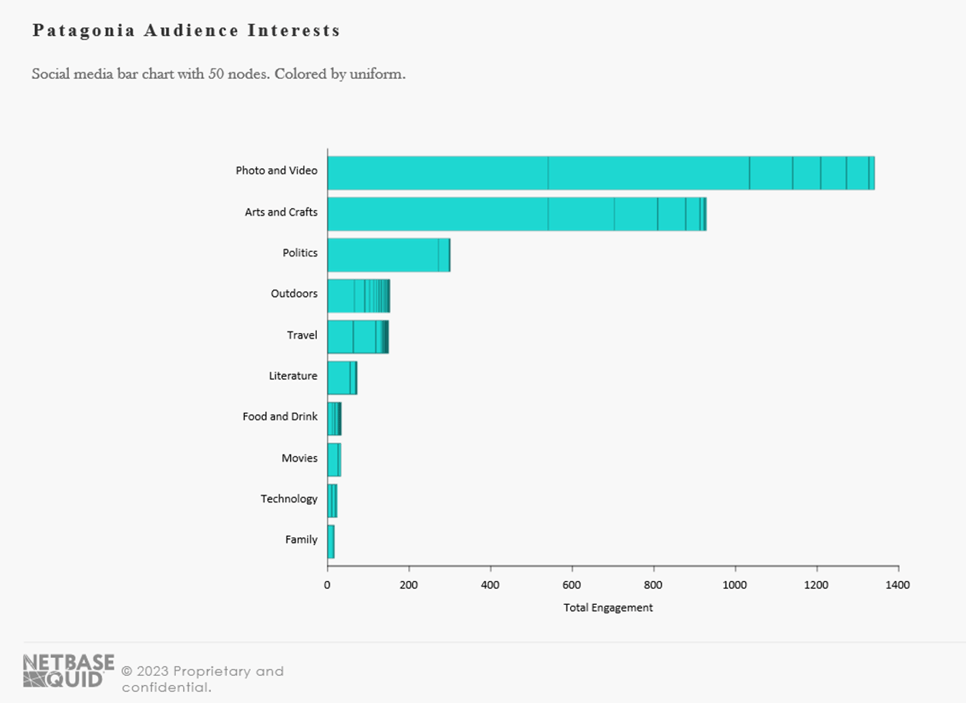
Additionally, personalization at scale is seeing tremendous interest. While many brands are still struggling to implement it on an enterprise level, those that have are reaping the benefits.
McKinsey reports, “Research shows that personalization most often drives 10 to 15 percent revenue lift (with company-specific lift spanning 5 to 25 percent, driven by sector and ability to execute). The more skillful a company becomes in applying data to grow customer knowledge and intimacy, the greater the returns.” Including the customer’s name in emails and chatbot conversations is a great place to start. Personalized recommendations or pain point suggestions based on consumer insights are additional ways to provide a customized consumer experience.
That little something extra adds a touch of humanity to digital interaction. It simply works.
As mentioned, speed to accurate intel is mission-critical with the global economy’s non-stop activity. Unfortunately, many companies still use too many platforms to cobble together their market research. If your Martech Stack has grown unwieldy, it’s time to change.
That’s because streamlined efficiency is the name of the game. When your market research analytics tools are under one umbrella, it makes all the difference in the world. Just remember, the spoils almost always go to the first mover. Cumbersome research methods and tools are not the recipe for success in today’s fast-paced climate.
When it comes to auditing your Martech Stack, you’ve got to be honest with what you need and what you don’t. Platforms and resources change over time, leading to unnecessary overlap, incompatibility issues, bloatware, and a general slowing down of your workflow. In addition, the more tools you’re working with, you heighten your chance of running into issues between tools.
Your data analytics tools are your eyes and ears in the marketplace and, therefore, one of your best hedges against threats. They inform every single one of the trends that we’ve covered here and more. If a robust suite of data analytics tools under one roof meets your brand’s needs, then that is the direction you need to go.
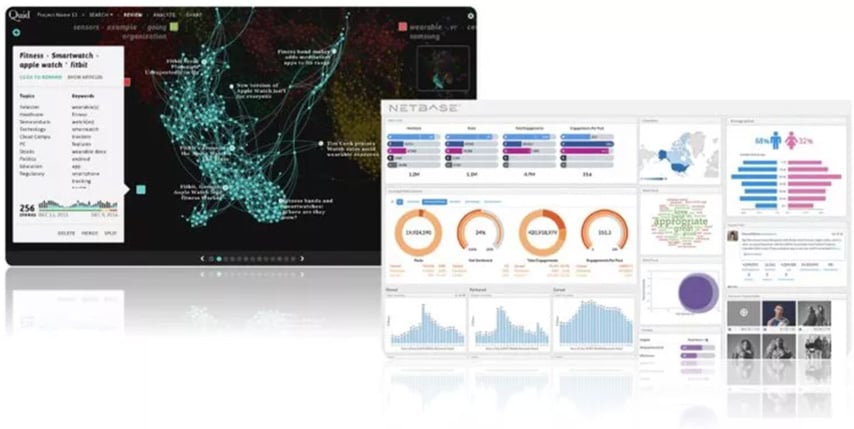
The entirety of the past few years has underscored the importance of being well-informed and staying agile. Brands across the globe are taking their market research to the next level in response and recognizing the value of an Quid Connect that makes every bit of insight accessible via one powerful BI platform.
This year will offer its unique challenges as the world attempts to keep the ship upright and steer around any icebergs. What’s left to be seen is how consumers will react to yet another wave of changes. Brands doing their due diligence in consumer and market intelligence will be ahead of the rest. Undoubtedly, this list of research trends represents a challenging set of objectives for any brand. But much of it builds upon the other. So analyze your goals, approach your low-hanging fruit and then expand your market research horizons from there. Finally, break it down and take a systematic approach.
What matters most is that you build upon accurate insights. Once your foundation is firm, the speed will come. Be sure to reach out for a demo, and we’ll be happy to help you kick your market research into high gear with world-class data analytics tools built on next-generation artificial intelligence.